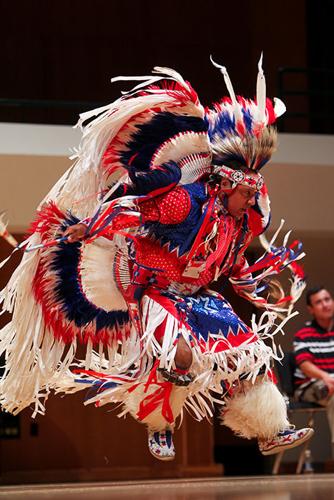From Europe to Asia, the Mediterranean and Scandinavia, the Oklahoma Fancy Dancers have spread their culture and their dance around the world, and they shared it, once again, at Catlett Music Center on Oct. 1, 2015.
The troupe participated in the Ruggles Native American Music Series, and shared dances such as the Fancy Dance, the Scalp Dance and the Shield Dance. With this, they also shared their culture, something that they hope to do every time they perform.
“We have two goals: educate and entertain,” said Kevin Connywerdy, director of the troupe, as he opened the night.
According to their biography, the dancers feel that Oklahoma’s unique heritage is a microcosm of the diversity and are proud to be able to share the history.
“The history of Oklahoma is unique in that it was the last place in what they considered a multi-tribal Indian territory,” manager Kricket Rhoads-Connywerdy said. "When you say Indian it means multi-cultural because each tribe has its own everything — its own government, language, attire, way of life; everything is as different as the Japanese are from the French."
Fancy dancing is a style of dance that is performed at Powwows. However, the style of dance wasn’t created until the 1920s and 30s by members of the Ponca tribe.
“Not every Native American person dances or sings,” Zack Morris said. "Somebody said Native Americans have always been a thankful people, a prayerful people, long before the Western civilization ever came to our lands, so there's things that we still do."
Morris wasn’t able to dance until he was in his 30s though.
“My dad was a Southern Baptist Minister, and baptists don't dance," Morris said. "It's been a blessing for me to see the world through song and dance.”
However, the dancing doesn’t typically wait until people reach an older age; they actually start when they're quite young. Four members of the troupe are under 13 years old — the Culture Club Princesses and two young boys that danced the shield dance.
“My mom and dad are running this, so I guess I kind of just went along with them from when I was really, really young,” said Angelyn Connywerdy, Culture Club Princess. "I've become pretty used to it. It's always been something that's a part of my life."
The dancers were also accompanied by four musicians and singers, but of two different styles: Northern and Southern. Northern style is higher pitched and uses a different type of drum than the Southern style.
However, the drumming isn’t the only thing that’s different. Other tribes, represented within the troupe, have different styles of dancing. Some dances are more choreographed than others, while others just have a general outline.







